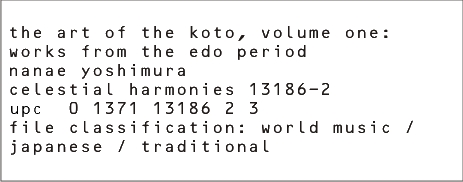 |
||||||||||||||||||
 
Lange war die Insel wie abgeschnitten vom Rest der Welt, ihre Kultur ein Rätsel. Selbst heute erscheint diese auf dem neuesten Stand des technischen Fortschritts agierende Wirtschaftsmacht in Vielem seltsam antiquiert. Manch eine Verhandlung mit Firmenbossen scheiterte an der Missachtung von Ritualen, die ins frühe Mittelalter zurückreichen. Wer geschäftlich mit Japan zu tun hat, sollte sich in die hier vorgestellte Musik einhören. Wer meditiert oder gar Zen praktiziert, wird manches kennen, kann jedoch auch einige Überraschungen erleben. Die Koto ist eine 13-saitige Harfe/Zither, 185 cm lang, 25 cm breit und 5 cm hoch. Die Saiten werden mit Plektren an Daumen und zwei Fingern der rechten Hand gezupft, während die linke Hand die Tonhöhe durch Druck auf die Saiten verändern kann. Klassischer Höhepunkt der Koto war die Edo-Periode (1600-1868). Damals hieß das heutige Tokyo Edo und hatte bereits über eine Million Einwohner. Die Koto und die Laute Shamisen werden meist von Frauen gespielt, hier von der weit über Japan hinaus bekannten Nanae Yoshimura und ihrer Freundin Satomi Fukami. Beide begannen ihr Studium im frühen Kindesalter. Fünf klassische Kompositionen, z.T. mit Gesang, die in die Stille führen. the project This recording, the first of three volumes reflecting on the history of the koto, brings together five representative pieces from the classical repertoire for the Japanese koto, composed between the mid–17th and mid–19th century. This corresponds roughly to the period of Japanese history known as the Edo, or Tokugawa period (1600-1868), when the country was ruled by the shoguns of the Tokugawa family from their castle in Edo, the former name of present–day Tokyo. The strict rule of an authoritarian adminstration and a rigid policy of national seclusion worked together to produce a relatively long period of freedom from the disruption of internal and external strife, during which the country changed and developed dramatically in social, economic and cultural terms. The music on this disc is largely a product of the daimyo, samurai and chonin merchant–class culture of the kamigata region of Kyoto and Osaka. This style of koto playing, known as the Ikuta school after the great master Kengyo Ikuta (1656-1750), also spread to and became popular in Edo and throughout the country soon after its emergence, but the new performance style championed by Kengyo Yamada (1757-1817) from the late years of the 18th century in Edo became extremely popular there, overwhelming the Edo representatives of the Ikuta school. Now the Yamada school is still largely confined to the area around modern Tokyo whereas many Ikuta school players, like Nanae, are also based there, and the Ikuta school dominates the koto-music scene in most other regions of the country. The koto belongs to the family of long zithers, and as with many other Japanese instruments, it can be traced back to the Asian mainland. Its history in Japan spans more than twelve centuries. The slightly convex body of the instrument is a hollow shell made of kiri, or paulownia wood, and its strings are traditionally made of silk, although nylon strings are now in common use. Booklet annotation is provided by Associate Professor Steven G. Nelson, the only Western member of staff at the new Research Centre for Japanese Traditional Music, Kyoto City University of Arts, Kyoto, Japan. the artists On this CD we hear two performers in the prime of their careers, Nanae Yoshimura and Satomi Fukami. Yoshimura was born in Tokyo and began to study the koto from the age of three, receiving her teaching license with the Matsu-no-mi Kai of Ikuta school koto performance at the age of sixteen. She studied the classical repertoire for koto and jiuta shamisen with Soju Nosaka of the Kyăshă lineage, and contemporary works for koto and nijugen (twenty–stringed koto) with Nosaka's daughter, Keiko Nosaka. She has been especially active as a specialist on the latter instrument since the early 1970s. The ideas that shaped Yoshimura's selection of the music on this disc were: music for the koto developed and reached its completion in the Edo period, and the pieces chosen should reflect the flow of that history; they should be representative, and set out in the order in which they were composed; the pieces should also be selected for the representative status of their composers and those selected according to these three criteria should perform a well–shaped program complete in itself. The result was the selection of Rokudan, Midare, Zangetsu, Gondan-ginuta and Chidori. Fukami, who appears on tracks 3 and 4, began to study the koto from an early age, and later studied with the late Kiyoko Miyagi (a former 'Living National Treasure') and Kazue Miyagi. biographydiscographytracklist
|
||||||||||||||||||
|
|
||||||||||||||||||
 |



